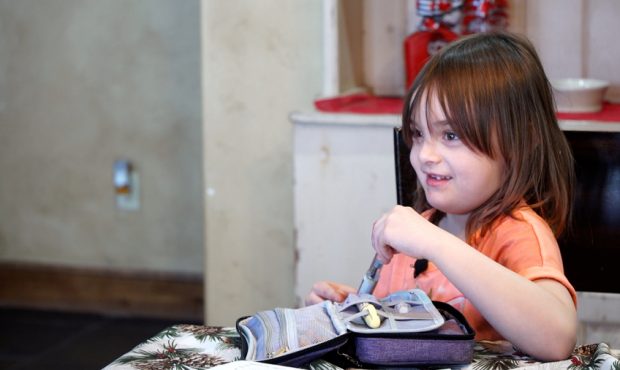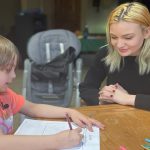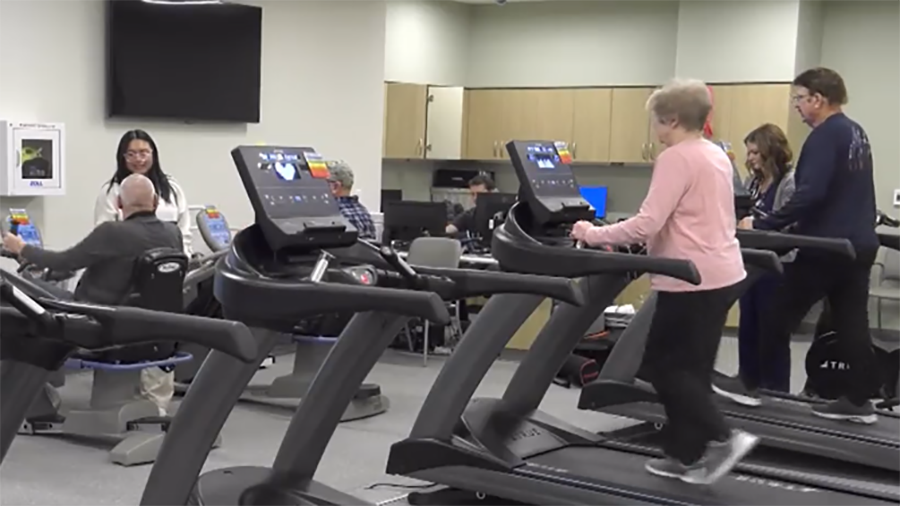CDC study: Diabetes may be more likely for some kids recovering from COVID-19
Jan 21, 2022, 5:10 PM | Updated: Jun 8, 2022, 6:14 pm

Bella Staker, age 6, got type 1 diabetes a few days after contracting COVID-19. (KSL TV)
(KSL TV)
DRAPER, Utah — There’s a worrisome trend among some kids recovering from COVID-19. Children who’ve had the virus appear to have an increased risk of getting both Type 1 and Type 2 diabetes.
At 6 years old, Bella Staker can make just about anything fun, even needles.
She knows how to test her blood sugar by herself, and how to read her glucose meter.
Last November, Bella was diagnosed with COVID-19. A few days later, she was in the emergency room with severe symptoms.
“Not being able to wake up; the sweating the throwing up, not wanting to move,” said Brandy Staker, Bella’s mother, who lives in Draper.
Doctors diagnosed her with Type 1 diabetes, an autoimmune disease that has no cure.
It’s a life-changing worry for her and her mom.
“When she’s at school, I have her nurse on speed dial in case I get an alarm on my phone saying, ‘Hey, she’s low,’” Staker said. “I call her because at any point, she can go into a seizure if she gets low enough. And that could affect her brain, her nervous system, everything.”
According to the Centers for Disease Control and Prevention, COVID-19 might induce diabetes in some children and teens.
Scientists found that children 18 and younger were more likely to get diabetes 30 days after having COVID-19 than those who didn’t get the virus.
One data set showed a 2.6 times higher risk; the other, a 30% increase.
That’s consistent with what doctors are seeing at Intermountain Primary Children’s Hospital.
“In 2021, we had about a 25% increase in diabetes, both Type 1 and Type 2,” Dr. Scott Clements, a pediatric endocrinologist at Primary Children’s, said.
Clements said he’s not surprised by the study’s results.
“Type 1 diabetes can often be triggered by environmental factors, such as viruses and other things. COVID could therefore be a trigger.”
Type 1 diabetes is most common in Utah children and teens. That’s why it’s so important to know the symptoms.
“Increased thirst, frequent urination, fatigue, weight loss, vomiting, and those are urgent symptoms, and kids need to be evaluated more quickly,” Clements said.
Both the CDC and Clements urge parents to get kids five and up vaccinated.
“There’s a potential that that will then prevent some cases of Type 1 diabetes,” Clements said.
Staker said, “She (Bella) has FOMO in a way: fear of missing out on everything.”
Despite her new diagnosis, Staker has high hopes for Bella.
“It’s something that shouldn’t hold her back in life,” she said.
Staker hopes to leave the surprises for playtime.
Doctors said both Type 1 and Type 2 diabetes are increasing rapidly in Utah.
Along with getting vaccinated, the risk of Type 2 diabetes can be decreased by following a healthy lifestyle.
“Whether that’s going to your local gym, going to a local community center, finding access to help keep your kid with a healthy lifestyle, access to healthy food and fruits and vegetables,” Clements said.
Teens with Type 2 diabetes may have no symptoms other than weight gain and darkening of the skin around the neck, which is called acanthosis nigricans.
“It’s very easy to miss. Almost every family says they thought it was dirt,” Clements said. “They’ve told their kid to wash their neck to get it off, but it doesn’t come off.”
If an overweight teen has the darkening of the skin around the neck, they should see their primary care provider and get checked for Type 2 diabetes or prediabetes, according to experts at Intermountain Healthcare.
Local programs to help families make lifestyle changes include Healthy Habits Healthy Families, offered by Intermountain Healthcare.
The intensive, six-month weekly program for children focuses on nutrition, physical activity and behavior change.
The program includes visits with a dietitian and physical therapist, as well as virtual and in-person small group activities.














